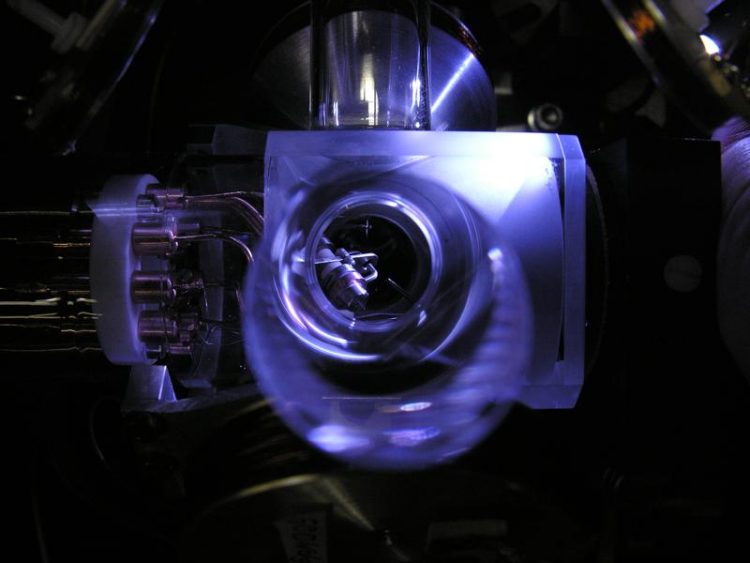The most accurate optical single-ion clock worldwide

Radio-frequency trap of PTB's optical ytterbium single-ion clock. (Photo: PTB)
Atomic clock experts from the Physikalisch-Technische Bundesanstalt (PTB) are the first research group in the world to have built an optical single-ion clock which attains an accuracy which had only been predicted theoretically so far.
As early as 1981, Hans Dehmelt, who was to be awarded a Nobel prize later, had already developed the basic notions of how to use an ion kept in a high-frequency trap to build a clock which could attain the – then unbelievably low – relative measurement uncertainty in the range of 1E-18.
Ever since, an increasing number of research groups worldwide have been trying to achieve this with optical atomic clocks (either based on single trapped ions or on many neutral atoms). The PTB scientists are the first to have reached the finishing line using a single-ion clock. Their optical ytterbium clock achieved a relative systematic measurement uncertainty of 3 E-18. The results have been published in the current issue of the scientific journal “Physical Review Letters”.
The definition and realization of the SI unit of time, the second, is currently based on cesium atomic clocks. Their “pendulum” consists of atoms which are excited into resonance by microwave radiation (1E10 Hz). It is regarded as certain that a future redefinition of the SI second will be based on an optical atomic clock. These have a considerably higher excitation frequency (1E14 to 1E15 Hz), which makes them much more stable and more accurate than cesium clocks.
The accuracy now achieved with the ytterbium clock is approximately a hundred times better than that of the best cesium clocks. To develop their clock, the researchers from PTB exploited particular physical properties of Yb+. This ion has two reference transitions which can be used for an optical clock.
One of these transitions is based on the excitation into the so-called “F state” which, due to its extremely long natural lifetime (approx. 6 years), provides exceptionally narrow resonance. In addition, due to the particular electronic structure of the F state, the shifts of the resonance frequency caused by electric and magnetic fields are exceptionally small.
The other reference transition (into the D3/2 state) exhibits higher frequency shifts and is therefore used as a sensitive “sensor” to optimize and control the operating conditions. Another advantage is that the wavelengths of the lasers required to prepare and excite Yb+ are in a range in which reliable and affordable semiconductor lasers can be used.
The decisive factor for the last leap in accuracy was the combination of two measures: firstly, a special procedure was conceived for the excitation of the reference transition. With this procedure, the “light shift” of the resonance frequency caused by the exciting laser is measured separately.
This information is then used to immunize the excitation of the reference transition against the light shift and its possible variation. Secondly, the frequency shift caused by the thermal infrared radiation of the environment (which is relatively small for the F state of Yb+ anyway) was determined with a measurement uncertainty of only 3 %. For this purpose, the frequency shift caused by laser light and its intensity distribution at the ion's location were measured at four different wavelengths in the infrared range.
Another particular property of the F state of Yb+ is the strong dependence of the state energy on the value of the fine-structure constant (the elementary fundamental constant of electromagnetic interaction) and on the anisotropy effects in the interaction between electrons and certain potential forms of the so-called dark matter which plays an important part in the present cosmologic standard model. Comparisons between Yb+ clocks and other highly accurate optical clocks are currently probably the most promising way of verifying theories from this area of “new physics” in the lab.
(es/ptb)
Contact:
Dr. Christian Tamm, Senior Scientist, Department 4.4, Subject Area “Optical frequency standards”, phone: +49 (0)531 5924415, e-mail: christian.tamm@ptb.de
Scientific publication:
N. Huntemann, C. Sanner, B. Lipphardt, Chr. Tamm, E. Peik: Single ion atomic clock with 3 E-18 uncertainty. Phys. Rev. Lett. 116, 063001 (2016)
Weitere Informationen:
http://www.ptb.de/cms/en/presseaktuelles/journalisten/press-releases/press-relea…
Media Contact
All latest news from the category: Earth Sciences
Earth Sciences (also referred to as Geosciences), which deals with basic issues surrounding our planet, plays a vital role in the area of energy and raw materials supply.
Earth Sciences comprises subjects such as geology, geography, geological informatics, paleontology, mineralogy, petrography, crystallography, geophysics, geodesy, glaciology, cartography, photogrammetry, meteorology and seismology, early-warning systems, earthquake research and polar research.
Newest articles

Superradiant atoms could push the boundaries of how precisely time can be measured
Superradiant atoms can help us measure time more precisely than ever. In a new study, researchers from the University of Copenhagen present a new method for measuring the time interval,…

Ion thermoelectric conversion devices for near room temperature
The electrode sheet of the thermoelectric device consists of ionic hydrogel, which is sandwiched between the electrodes to form, and the Prussian blue on the electrode undergoes a redox reaction…

Zap Energy achieves 37-million-degree temperatures in a compact device
New publication reports record electron temperatures for a small-scale, sheared-flow-stabilized Z-pinch fusion device. In the nine decades since humans first produced fusion reactions, only a few fusion technologies have demonstrated…





















